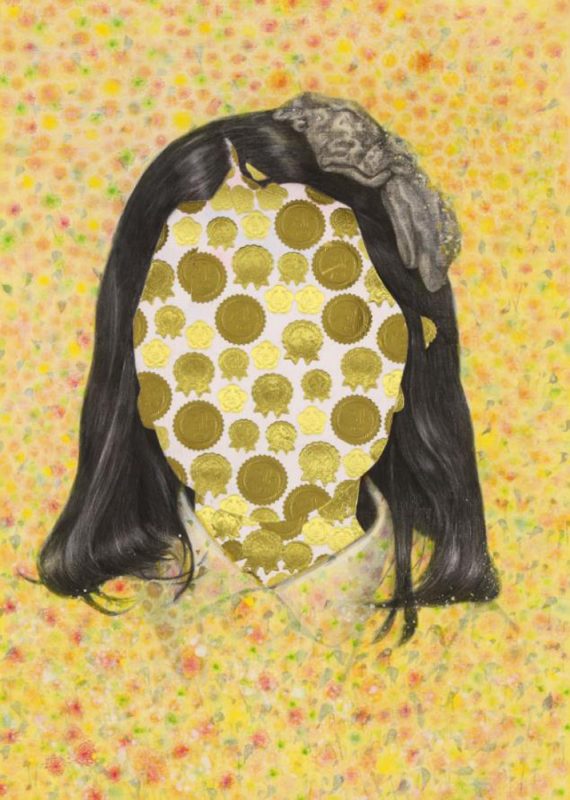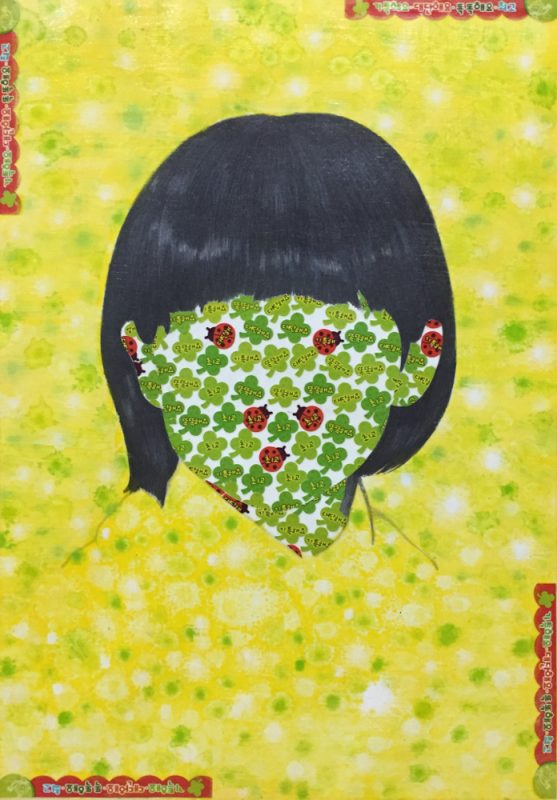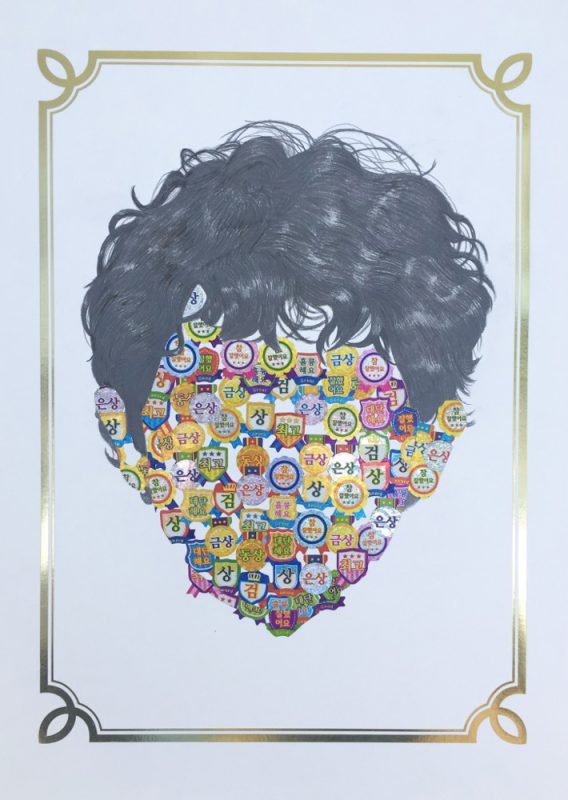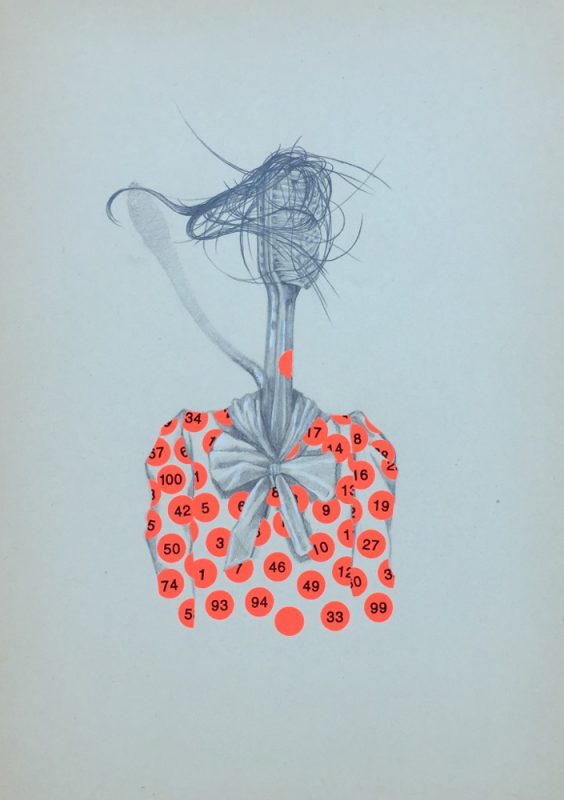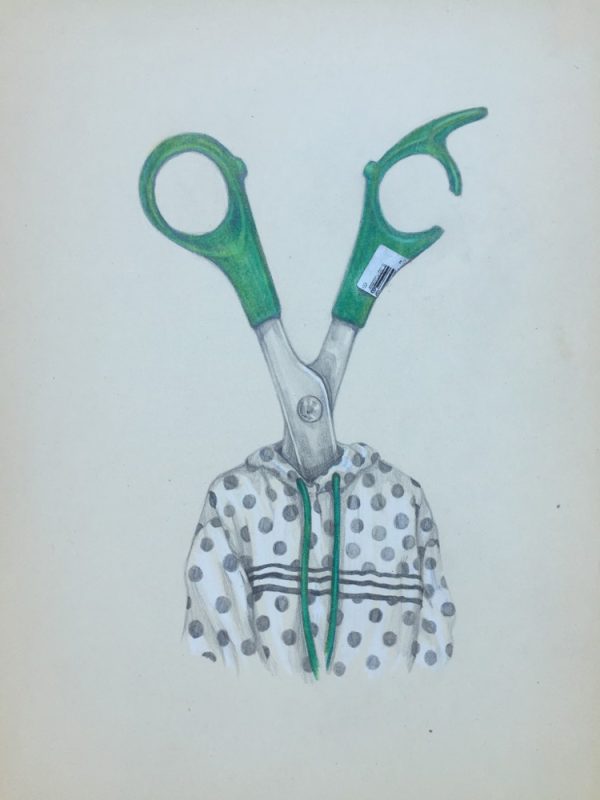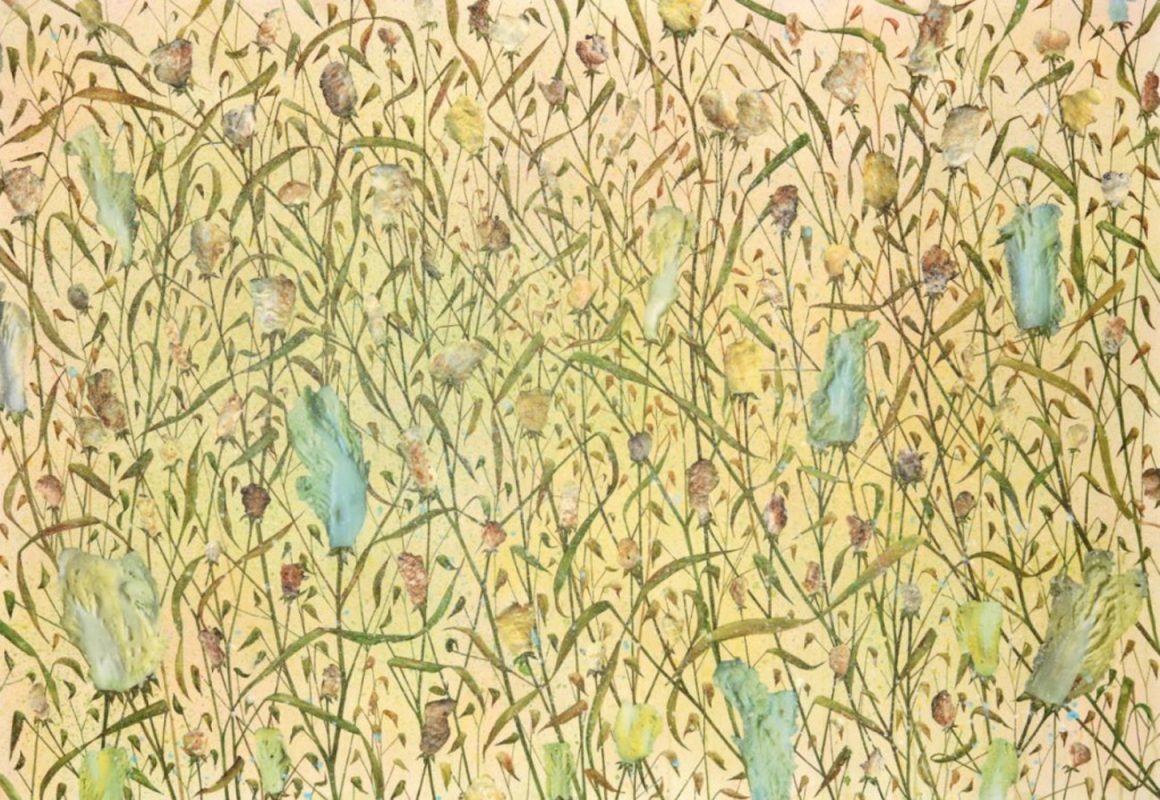부:치다
Song Hana
환시와 착각을 발생시키는 라벨
이미지는 실제가 아니라 허상이다. 그것은 진짜인 척하는 가짜. 거짓인 눈속임이다. 그러나 우리는 이미지를 실제와 동일시하면서 부단히 속아 넘어간다. 이미지의 눈속임을 지워 나가려는 시도가 모더니즘이었지만 미술은 여전히 부실한 우리 눈을 공략하는 놀이이자 착시와 환시, 환각을 겨냥하는 다양한 시도를 근간으로 이루어지고 있다.
송하나의 작업을 일종의 반전과 전복을 배면에 깔고 있다. 보는 이의 눈을 헛짚게 만들거나 순진한 믿음을 슬그머니 배반한다. 보는 것이 진실이거나 전부가 아니라는 사실을 새삼 깨닫게 한다. 이미지가 지닌 착각과 눈속임을 적극적으로 자신의 작업의 주된 기제로 끌어들이는 한편 이러한 방법론을 통해 구체적인 일상에서 경험되는 아이러니한 배리의 감정을 해학적이면서도 날카롭게 비튼다. 그러니까 이미지의 숙명적인 한계를 통해 현상 이면에 자리한 진실을 다시 보게 하려는 시도가 송하나 작업의 주된 축이다.
이번 작업은 공통적으로 라벨/스티커를 사용해 이를 콜라주해서 ‘붙인다’는 언어적 수사를 희롱한다. 우선 특정 이미지가 전사된 스티커가 꽃이나 얼굴을 대신한다. 꽃밭이거나 학생들의 초상으로 보이지만 근접해서 바라보면 그것은 일상의 공간에서 무작위로 붙어 다니는 전단지의 파편이거나 원형의 금박, 은박으로 인쇄된 스티커 상賞이다. 이는 실재를 대신하는 가짜이자 환시와 착각을 발생시키는 트릭이다. 아울러 하찮은 일상의 남루한 오브제들이 역설적으로 아름다운 꽃을 대신하는 연출이거나 매혹적인 꽃으로 보이는 것들이 실은 예측할 수 없는, 예기치 못한 낯선 이미지들로 마구 출현하는 당혹감을 접하게도 한다. 보이는 것과 보이지 않는 것의 관계를 질문한다. 아울러 시차와 거리에 따라 달라지는 화면은 보는 이이 개입에 의해 작품이 완성되는 상호관련성을 흥미롭게 보여준다.
한편 얼굴이자 상징으로 도배된 이상한 초상은 반짝이는 스티커상장이 방증하듯 허상과 허명이 대신하는 페르소나의 은유일 것이다. 그럴듯해 보이는 싸구려, 가짜의 반짝임으로 이루어진 이 키치는 늘상 실체를 대리하면서 연기한다. 그것이 또한 동시대 우리들의 삶과 문화의 초상이고 우리들 각자의 얼굴이기도 하다.
한편으로 실용성의 운명에서 풀려난 일상의 용기들, 그렇게 인간이 쓰고 버린 일련의 도구와 사물들을 수습해서 이를 마치 영정사진처럼 드로잉하고 이 몸체에 부분적으로 라벨로 콜라주한 것도 있다. 라벨은 화려하고 아름다운 문양을 사물의 피부에 덧씌워주고 그 사물에 이름을 명기해준다. 그로 인해 죽은 사물, 폐기된 존재는 새삼스럽게 환생하고 또 다른 존재로 다가온다. 이는 애도의 과정이자 인간 중심적인 시선에서 재단된 사물들을 그로부터 이탈시켜 존엄한 대상으로, 실존적으로 길어 올리는 행위에 해당한다.
송하나의 작업은 보이는 외형이 진실을 은폐하거나 대리하는 것들을 건드리는 한편 허상과 실상의 관계, 보는 것의 의미, 그리고 표면과 이면의 관계 등을 라벨 작업을 통해 흥미롭게 보여준다. 그 안에는 보는 즐거움과 반전의 묘미가 잠복해 있고 일상에서 우연히 발견한 현상을 유심히 들여다보면서 그 안에서 만만치 않은 메시지를 길어 올리는 통찰도 번득인다.
■ 박영택 (경기대 교수, 미술평론가)
⠀⠀⠀
⠀⠀⠀
⠀⠀⠀
Labels that Generate Hallucinations and Illusions
Every image is just an illusion. It is something fake that pretends to be real through an optical trick. We ourselves are often deluded into identifying this image as something real. Although modernism tried to eschew such optical tricks, art is still a play to tackle our incomplete perspective and an attempt to bring about a variety of illusions, delusions, and hallucinations.
Song Hana’s work is dependent on a sort of reversal and overturn. It makes the viewer’s eye perplexed or betrays their confidence furtively. It makes viewers realize there is more to her work than meets the eye. She aggressively employs delusions and optical tricks images can cause as the cardinal mechanism of her work, lending a humorous, keen twist to ironic feelings of irrationality experienced in the concrete everyday. That is to say, Song’s work makes a foray into enabling viewers to see the truth masked by phenomena by pointing out the destined limitations of images.
Her works on show at this exhibition toy with the linguistic expression of “putting something on” by collaging labels or stickers. The stickers on which a specific image is transcribed substitute flowers or faces. Her images look like a flower garden or a student’s portrait but they are pieces of flyers commonly found on the street with round gold or silver-gilt stickers. These are fakes replacing the real and employed as tricks to bring about delusions. In addition, viewers encounter shabby, insubstantial objects that paradoxically replace beautiful flowers or seemingly alluring flowers appear as unpredictable, unfamiliar images. Her work poses a question concerning the relation between the visible and invisible. Her scenes that look different depending on time and distance are an interesting showcase of the interrelationship between the viewer and the artwork.
The faces and uncanny portraits full of symbols are perhaps a metaphor for persona replaced with virtual images and empty reputations, as evidenced by glittering certificates of merit. Seemingly plausible cheapies or pretentious show-off kitsch substitutes for and act for the truth. These are portraits of our lives and culture and faces of our time.
Some are sketches of quotidian receptacles that escaped the fate of practicality and implements which were once used but are now thrown away. These drawings look like portraits of the deceased. Others are in part collaged with labels. The skin of things is overlaid with labels and the names of those things are specified by those labels. Things killed and disused by this practice are reincarnated and appear as other beings. As a process of sending condolences, this is an action of existentially elevating things to objects with dignity by liberating those things gauged from any human centered perspective.
Song’s work is an interesting representation of the relation between false and real images, the meaning of seeing, and the relation between the outside and inside using labels. The allure of reversal and pleasure are inherent in her work. It is also laden with her insight to draw out some serious messages from serendipitous discoveries in her everyday life.
■ Park Youngtaik (Kyonggi University Professor & Art Critic)



